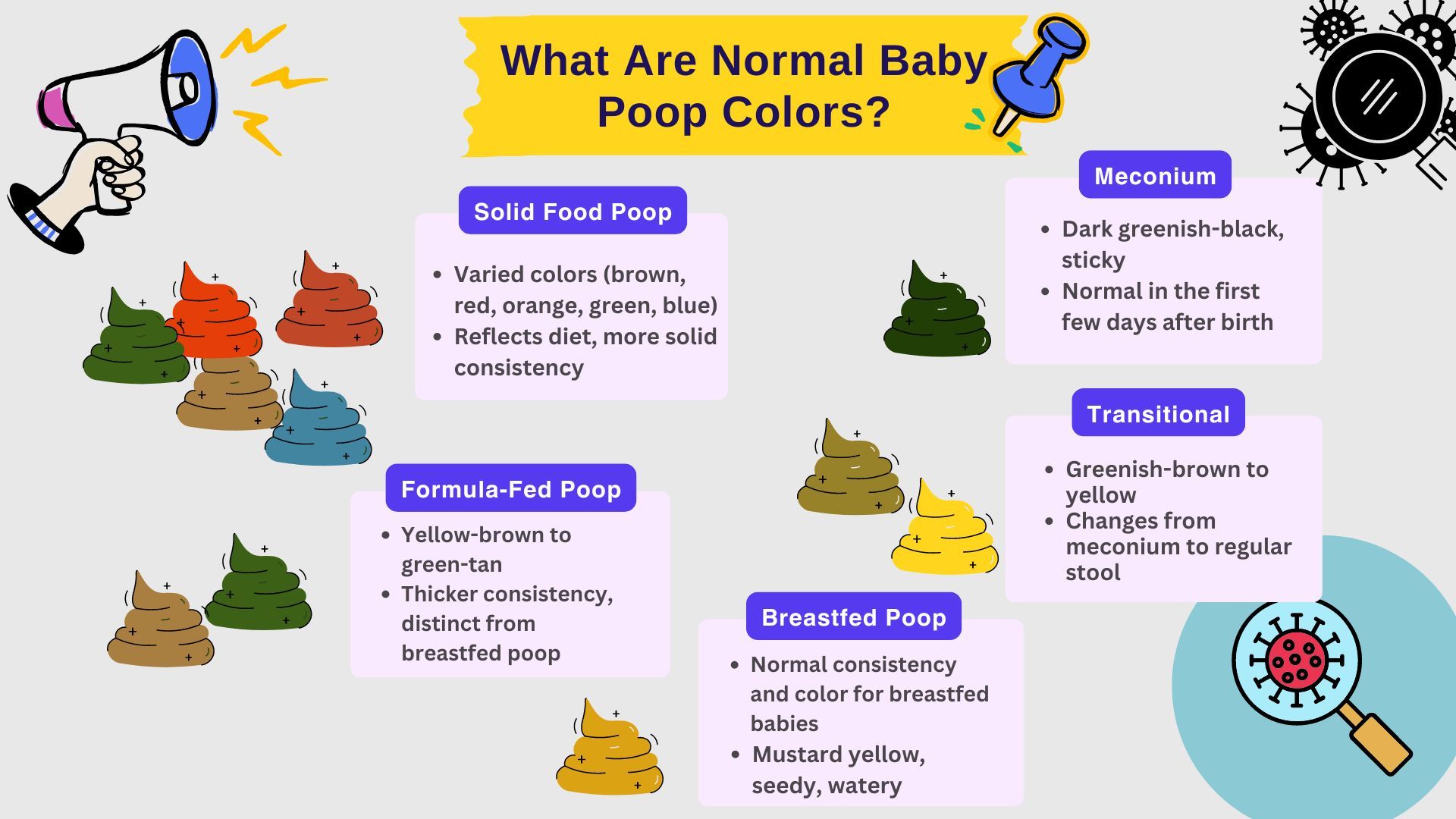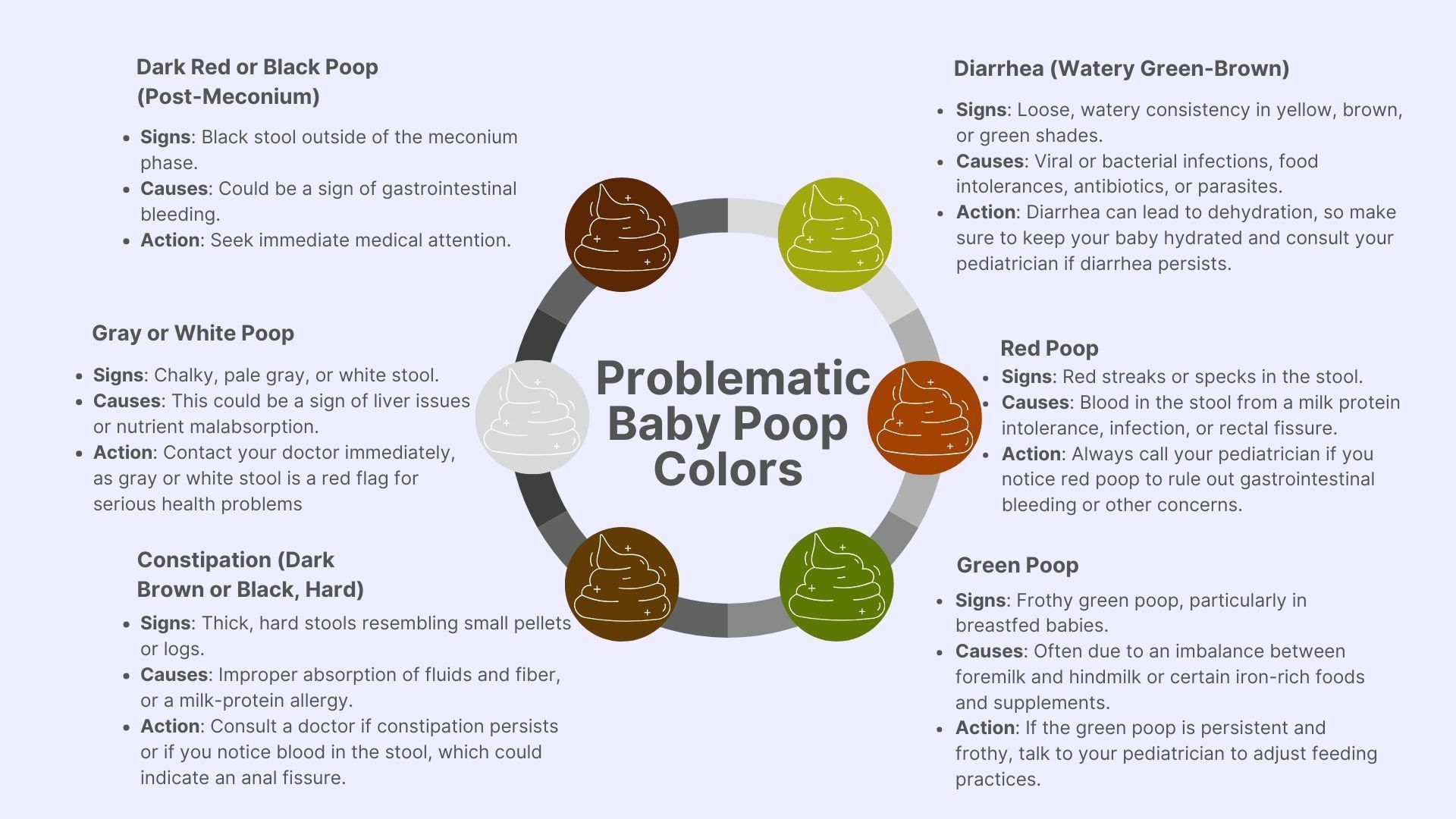Confused about Baby Poop Color? Our guide breaks down what’s normal and when to seek medical advice. Keep track of your baby’s health with ease.

Your baby’s poop colors can actually tell you a lot about their overall health. From the first black tar-like meconium to the vibrant hues that follow, each shade can provide clues about how your baby is digesting milk, absorbing nutrients, and even fighting off an infection.
Baby poop colors may change daily, especially during the first few months. But don’t worry, These variations are usually a normal part of development. However, there are some shades that may require a closer look, just to ensure everything is going as it should. Let’s break it down.
What Are Normal Baby Poop Colors?

Dark Greenish-Black
If you’re reading this while expecting or in the early days after birth, you might still be in the meconium stage. The first time you change your baby’s diaper, you’ll notice a dark greenish-black, sticky substance. This is meconium—a mix of amniotic fluid, bile, and secretions from your baby’s intestines. It’s a bit shocking at first because it looks nothing like normal poop, but it’s completely normal.
- Why It Happens: Meconium is your baby’s way of cleaning out everything they ingested while in the womb.
- When to Expect It: Within the first 24 hours after birth and continuing for up to two to four days.
- Action: If your baby doesn’t pass meconium within the first couple of days, you should see a healthcare provider. It could indicate an intestinal blockage.
Meconium is super sticky and can be tricky to clean off your baby’s delicate skin. Try applying a thin layer of petroleum jelly to their bottom during the diaper change to help prevent sticking and make cleanup easier.
Greenish-Brown to Yellow
As you move out of the meconium phase, your baby’s poop will transition to a mix of meconium and regular stool. This stage can be a little wild—expect some greenish-brown shades. Over the next few days, it will begin to turn yellow or light brown as your baby starts to digest milk or formula.
- When to Expect It: 2-4 days after birth.
- Color: Dark green to brown, eventually lightening to yellow or tan.
- Consistency: Sticky but softer than meconium.
This stage is a sign that your baby is starting to adjust to life outside the womb and is getting the nutrients they need from breast milk or formula. Consider it a good sign that things are progressing as they should.
Mustard Yellow, Seedy, and Watery
Around the end of your baby’s first week of life, their poop will change to a light yellow color. For breastfed babies, this poop can be watery, runny, and often seedy, resembling mustard. It might even remind you of scrambled eggs, While that might sound a bit unappetizing, this stage is completely normal and expected for breastfed babies.
- Color: Mustard yellow, sometimes with a hint of green.
- Consistency: Watery or runny, sometimes with a seedy texture.
- Smell: Surprisingly mild, almost sweet compared to formula-fed baby poop.
Yellow-Brown to Green-Tan
If you’re formula-feeding your baby, their poop will look different than that of a breastfed baby. The color will usually be somewhere in the yellow-brown to green-tan range, and the consistency will be thicker, similar to peanut butter or toothpaste. Formula is harder to digest than breast milk, so it results in firmer stools.
- Color: Yellow-brown, tan, or light green.
- Consistency: Thicker and firmer than breastfed poop—think peanut butter or even toothpaste.
- Smell: Slightly stronger and more pungent than breastfed poop.
If you’re feeding a combination of breast milk and formula, you can expect baby poop colors to be somewhere in between—perhaps a little firmer and browner than breastfed poop but not as thick as an exclusively formula-fed stool.
Varied Colors
As your baby starts eating solids, their poop will undergo a major transformation. You’ll likely see an array of colors depending on what they eat—sometimes red, orange, green, yellow, or even blue (looking at you, blueberries). The consistency will also firm up and become more like adult poop.
- Color: Varies widely depending on diet—everything from brown to red, orange, and even green or blue.
- Consistency: Firmer, sometimes with undigested food chunks.
- Smell: You’ll notice a much stronger odor now that solid foods are part of the equation.
During this stage, it’s not unusual to see bits of undigested food in your baby’s diaper. Certain foods, like corn or peas, don’t break down completely in the digestive tract and will pass through in recognizable chunks. This is normal and nothing to worry about.
Problematic Baby Poop Colors to Worry About
While most baby poop colors are perfectly normal, there are a few shades that could signal a problem. Here’s what to watch for:

Watery Green-Brown (Diarrhea)
Diarrhea in babies typically presents as loose, watery stools in colors ranging from yellow to greenish-brown. It can be caused by viral or bacterial infections, food intolerances, or reactions to antibiotics. If your baby has diarrhea, it’s crucial to keep them hydrated to prevent dehydration.
Offer fluids regularly and consult your pediatrician if diarrhea persists for more than a couple of days, especially if accompanied by symptoms like fever or vomiting. Persistent diarrhea may need further medical evaluation to identify the cause.
Dark Brown or Black, Hard (Constipation)
Constipation in infants is marked by hard, dark brown, or black stools that are difficult to pass. Causes can include insufficient fluid intake, a milk-protein allergy, or other dietary issues. If your baby shows signs of constipation, such as straining or hard stools, consult your pediatrician.
Persistent constipation or the presence of blood in the stool requires medical attention. Proper diagnosis and treatment are essential to address any underlying issues and provide relief.
Red Baby Poop
Red baby poop colors usually indicate the presence of blood, which can be alarming for any parent. Small streaks of red might be caused by a milk protein allergy, an anal fissure due to constipation, or even blood swallowed from a cracked nipple during breastfeeding. While these causes aren’t typically severe, you should still consult your pediatrician to rule out other concerns.
If you notice dark red or significant amounts of blood, this could indicate gastrointestinal bleeding or a serious infection, requiring immediate medical attention. Always err on the side of caution when red poop persists.
Green Baby Poop
Green baby poop colors can appear due to various reasons and are usually not a cause for concern. In breastfed babies, green stool can result from an imbalance between foremilk (the lower-fat milk at the beginning of a feeding) and hindmilk (the richer, high-fat milk). This leads to frothy green stools.
In formula-fed babies, iron supplements or iron-fortified formula can turn the stool dark green. Additionally, if your baby is teething or has started solid foods, green veggies or baby food can also change poop to green. However, if green poop is accompanied by diarrhea, mucus, or an unusual smell, consult your pediatrician.
Black or Dark Red Poop (Post-Meconium)
Black or dark red baby poop colors are a serious concern after the meconium phase. This can indicate digested blood from gastrointestinal bleeding, which could be due to ulcers, severe allergies, or other serious conditions.
Iron supplements can sometimes cause black stool, but it’s essential to contact your pediatrician if you notice black or dark red poop to rule out more serious health issues.
Chalky White or Gray Poop
White or gray baby poop colors signal a problem with bile production, which is critical for digestion. These pale shades might indicate a liver or bile duct issue that requires immediate medical attention. If your baby’s stool is consistently gray or white, contact your pediatrician promptly to investigate possible liver concerns.
Conclusion
Baby poop colors offer valuable insights into your baby’s health. While many colors like yellow, brown, and green are normal, others—like red, black, white, or gray—could indicate a health issue and warrant medical attention. Monitoring these changes and acting when something seems off can help you ensure your baby is healthy and happy.
So what color do your baby poop have? Let me know in the comments.
You may also be interested in : New Mom Tips: How To Get Baby on A Sleep Schedule in The First Year